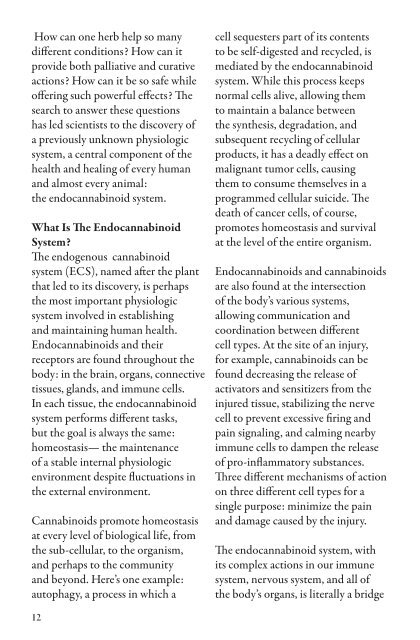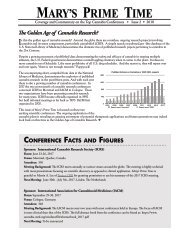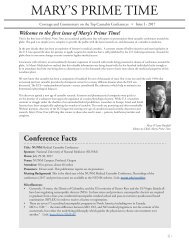#3: The Endocannabinoid System
Mary's Cannabis Primer is published as a resource for national and international education about the benefits of Cannabis. This issue focuses on the science of the Endocannabinoid System, and how THC affects the brain and the body.
Mary's Cannabis Primer is published as a resource for national and international education about the benefits of Cannabis. This issue focuses on the science of the Endocannabinoid System, and how THC affects the brain and the body.
Create successful ePaper yourself
Turn your PDF publications into a flip-book with our unique Google optimized e-Paper software.
How can one herb help so many<br />
different conditions? How can it<br />
provide both palliative and curative<br />
actions? How can it be so safe while<br />
offering such powerful effects? <strong>The</strong><br />
search to answer these questions<br />
has led scientists to the discovery of<br />
a previously unknown physiologic<br />
system, a central component of the<br />
health and healing of every human<br />
and almost every animal:<br />
the endocannabinoid system.<br />
What Is <strong>The</strong> <strong>Endocannabinoid</strong><br />
<strong>System</strong>?<br />
<strong>The</strong> endogenous cannabinoid<br />
system (ECS), named after the plant<br />
that led to its discovery, is perhaps<br />
the most important physiologic<br />
system involved in establishing<br />
and maintaining human health.<br />
<strong>Endocannabinoid</strong>s and their<br />
receptors are found throughout the<br />
body: in the brain, organs, connective<br />
tissues, glands, and immune cells.<br />
In each tissue, the endocannabinoid<br />
system performs different tasks,<br />
but the goal is always the same:<br />
homeostasis— the maintenance<br />
of a stable internal physiologic<br />
environment despite fluctuations in<br />
the external environment.<br />
Cannabinoids promote homeostasis<br />
at every level of biological life, from<br />
the sub-cellular, to the organism,<br />
and perhaps to the community<br />
and beyond. Here’s one example:<br />
autophagy, a process in which a<br />
cell sequesters part of its contents<br />
to be self-digested and recycled, is<br />
mediated by the endocannabinoid<br />
system. While this process keeps<br />
normal cells alive, allowing them<br />
to maintain a balance between<br />
the synthesis, degradation, and<br />
subsequent recycling of cellular<br />
products, it has a deadly effect on<br />
malignant tumor cells, causing<br />
them to consume themselves in a<br />
programmed cellular suicide. <strong>The</strong><br />
death of cancer cells, of course,<br />
promotes homeostasis and survival<br />
at the level of the entire organism.<br />
<strong>Endocannabinoid</strong>s and cannabinoids<br />
are also found at the intersection<br />
of the body’s various systems,<br />
allowing communication and<br />
coordination between different<br />
cell types. At the site of an injury,<br />
for example, cannabinoids can be<br />
found decreasing the release of<br />
activators and sensitizers from the<br />
injured tissue, stabilizing the nerve<br />
cell to prevent excessive firing and<br />
pain signaling, and calming nearby<br />
immune cells to dampen the release<br />
of pro-inflammatory substances.<br />
Three different mechanisms of action<br />
on three different cell types for a<br />
single purpose: minimize the pain<br />
and damage caused by the injury.<br />
<strong>The</strong> endocannabinoid system, with<br />
its complex actions in our immune<br />
system, nervous system, and all of<br />
the body’s organs, is literally a bridge<br />
12










